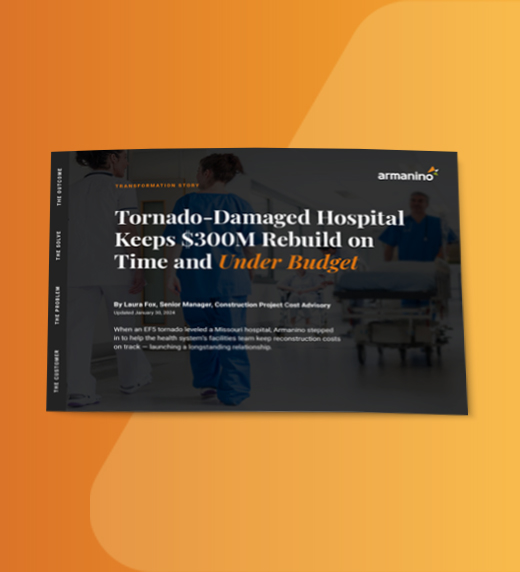
In the face of increasing costs, record inflation and abundant competition, healthcare organizations’ overhead expenses are rising at an unsustainable rate. Combine this with staffing shortages, supply chain strain and added industry regulations, and the prospect of remaining profitable can feel increasingly daunting.
That’s why now is the time to improve your revenue cycle.
An effective revenue cycle ensures that you are billing and collecting payment in a timely fashion, allowing you to offset other costs and alleviate some of the growing pressure placed on your organization. Additionally, the transition from fee-for-service to value-based care reimbursement — and the growing frequency that revenue is tied to patient engagement — forces the revenue cycle to work more closely with the total provider processes.
To stay competitive and adapt to industry changes, healthcare providers must also find new approaches to improve operational efficiencies, reduce costs, meaningfully engage patients and maximize internal bandwidth. By examining your revenue cycle and pinpointing areas where you can leverage technology to bolster operations and spur innovation, you can shorten the length of the cycle, optimize your current resources — and set your organization up for sustainable profit and growth.
Leveraging technology as a foundation of your revenue cycle is necessary to streamline workflows, reduce manual labor and lessen the potential for bottlenecks further down the line.
While the traditional process of patient scheduling and registration involved the patient making a phone call and speaking with a scheduler, today’s patients expect to be able to make an appointment online with the swipe of a finger. If your healthcare organization does not already have a secure patient portal that allows for scheduling and sharing information, now is the time to invest in one.
In the past two decades, studies have shown that healthcare administrative costs, including billing and coding, physician administrative support and insurance administration (including insurance verification), have accounted for roughly 15% to 25% of total national health expenditures. Streamlining these processes will improve cashflows and reduce costs.
Additionally, co-pay collection is a critical component of your process improvement journey. The increasing number of high-deductible plans has been tied to lower insurance premiums but has also made the collection of co-pays even more difficult.
Using a modern technology stack that includes tools like eligibility verification and patient estimation software allows you to ascertain a patient’s insurance coverage prior to treatment, reducing the probability of insurance denials later on. Understanding pricing and cost information also is critical as part of the Price Transparency Act.
By getting an accurate insurance coverage verification, you can also get an immediate estimation of what the patient’s responsibility will be. As a result, you can start collecting co-pays before a patient encounter begins or before they even enter the building. This quick verification and up-front collection gives you the ability to get revenue at the door — a much more streamlined process compared to a bill sent by mail 30 days later.
Documenting all pertinent information from each patient encounter is essential to capture a 360-degree view of each patient. However, many healthcare organizations are still struggling with integration, working with a jumble of disparate, legacy systems that don’t communicate with one another. If the patient data you document in your electronic health record (EHR) system is disconnected from other key systems — for example, a physician’s office or urgent care provider can’t share information — this can lead to a limited picture of your patient’s health, resulting in shortsighted decision-making and suboptimal patient care.
These system silos can also impact medical coding. It’s important that all charges are captured in your EHRs and that they’re being processed and coded correctly to ensure you capture the patient’s total acuity and there are no issues downstream. Correct coding is essential especially in risk-based and value-based contracts. By integrating technology platforms, you can improve coding accuracy, mitigate errors, optimize payments and ensure more favorable outcomes through a seamless integration of patient data.
Charge entry, the process of assigning appropriate diagnosis codes, procedure codes and modifiers to a patient account for services rendered, is an essential piece of the revenue cycle. Often done manually, it can be a tedious and error-prone process. Manual processes can lead medical errors, which is one of the leading causes of patient death.
Automating your charge entry allows you to automatically connect services provided and appropriate billing. For example, if you perform a service and the appropriate data capture and sharing is automated, billing and collections are greatly enhanced. This also saves your employees time that they previously had to spend submitting manual information, freeing them up for additional tasks.
When you’re looking at ways to improve your revenue cycle, there are three key objectives to consider: achieving a higher percentage of claims accepted by the insurance company in the first submission, ensuring that what you get paid matches your payor contracts, and achieving a higher percentage of denials managed to resolution (i.e., minimizing write-offs). Meeting these goals is largely dependent on successfully completing each of the preceding phases of the revenue cycle, ensuring that you’ve taken all up-front measures necessary to smoothly navigate the claims process.
To reduce administrative overhead and streamline inefficiencies, you may want to re-examine your claims process and determine where you can leverage technology to shorten your cycle and increase productivity. Artificial intelligence (AI) tools and robotics, for example, can be used to automate denial management and scale productivity without adding headcount.
You may also want to consider automation opportunities for your claim status checks. This is one of the most time-consuming pieces of the revenue cycle when done manually, and when your teams are understaffed, it becomes even more burdensome. Automating this process where possible allows you to reduce personnel time and more effectively deploy your resources. For example, robotic process automation can mimic human behavior on a rules-based task for repetitive processes and run continuously in the “background” for these tasks without manual supervision.
Accounts receivable (A/R) follow up, appeals and patient statements are all inextricably tied. Your revenue cycle will ultimately send patient statements out, in the form of collections or collection resolution. Insurance companies will be sending Explanations of Benefits (EOBs) to the patient that should match any outstanding patient payments. This process should be automated, which includes double- and triple-check processes to ensure accuracy. A delay in billing means that you have increased the days spent in A/R, in turn stalling your cash flow and occupying employee resources that could have been devoted to more strategic, value-added items.
The longer your charges are outstanding, the less likely you are to be able to collect. And, if this charge eventually gets passed along to a debt collections agency, your organization will lose a portion of the delinquent debt to cover the collection agency fee if any payment is collected.
In the healthcare industry, the only constant is uncertainty. Transforming your healthcare organization now, and optimizing critical phases of your revenue cycle, is a crucial way to improve your cash flow, reduce overhead, maximize your resources and future-proof your organization.
Getting a holistic assessment of your revenue cycle can help you identify areas where you can leverage technology to optimize and automate your services. This can help you make the most of your resources, alleviate your most pressing pain points and position your organization for long-term success.
Armanino’s healthcare experts can provide an assessment of your people, processes and technology to help you determine a sustainable path forward. To learn more, visit our Healthcare Industry page.


